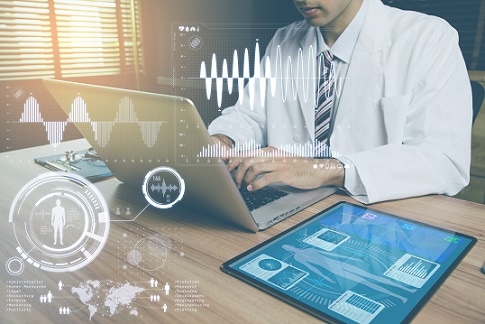Digital enablement introduces some important considerations, namely the need for a strategy around data interpretation. But it also unlocks untold possibilities, among them an answer to healthcare’s impending labor shortage.

As you read this, a medical tool could reveal a ticking time bomb for your health -- and it’s ticking away electronically on your wrist. The sensors in a typical smartwatch can track increasingly sophisticated biomarkers, which a generation ago would’ve read like science fiction. No longer: Apple’s ECG app can conduct an electrocardiogram from your wrist through an electrical heart sensor and analyze the data for atrial fibrillation to see if the upper and lower chambers of your heart are out of sync.
The capabilities for wearable devices go well beyond that. Sleep metrics can read your REM cycle. Motion sensors can keep tabs on your elderly neighbor’s stride length, flagging asymmetric walking tendencies to code their risk of taking a fall. Heartbeat monitors can track AFib history for a patient under cardiac care.
Wearable devices and other digital tools make all of that possible. And they also enable doctors to communicate what to do about it, all from the comfort of your home.
Almost overnight, the COVID-19 pandemic digitized healthcare. Telehealth was once used by just 1% of US healthcare patients, but visits jumped to more than 50% in the early months of the pandemic. It’s here to stay. Following the rise of virtual health, physicians now leverage modern digital technology to monitor patients in real time, which in turn spurs more advanced, personalized care.
Digital enablement introduces some important considerations, namely the need for a strategy around data interpretation. But it also unlocks untold possibilities, among them an answer to healthcare’s impending labor shortage.
Innovation Isn’t New, But It Will Continue
The pandemic may have accelerated the path to digital, but it certainly didn’t start it. Back in 2019 before the pandemic was full blown, I argued the benefits of telehealth in this article. In 2018; telehealth saved an estimated 17.7 million miles of travel for outpatient appointments in Western Australia. And in 2019, telehealth appointments grew to 22% adoption among US physicians, up from just 5% in 2015. Indeed, visions of tech-enabled healthcare predate modern medicine itself. A cover story in the defunct magazine “Science and Invention” proposed a doctor diagnosing a patient via telautograph, with examinations by video feed and remote instrumentation, in 1925 -- nearly a hundred years ago.
Today’s digital tools enable that and more. Through virtual consultations, doctors can review their patients’ symptoms and suggest further investigations, from 2D echocardiograms performed at home to wearable Holter monitors and other cardiac markers. Remote diagnostics shared with providers help form a broader digital ecosystem, with virtual follow-ups to prescribe medication delivered to patients’ homes. And the innovation has just begun. Future wearables will deliver even more metrics to healthcare providers, all at the tap of a screen.
There’s just one problem: All those biometrics will exponentially increase the amount of data to an industry already swimming in it.
Already, less than 10% of data available is being used today. If the entire healthcare chain -- doctors, hospital networks, insurance providers, pharmacies -- is already submerged in data, biometrics could inundate it even more. That makes it even more crucial for stakeholders to develop a strategic approach.
Surfing the Data, Not Swimming in It
With more data comes the imperative to manage it. Few incumbent players in healthcare are designed to accept as much data as the biometric revolution could soon supply. Cloud-based services offer one way to efficiently compile and store it, but only if the cloud is treated as a tool instead of a warehouse. Cloud computing gives phenomenal scalability if you’re careful about what data you’re using and how you plan to use it.
Effective cloud users will develop a disciplined cycle of sensing, analyzing, processing, storing, and learning from the data, as well as sharing it. Ineffective users will just end up with noise. And all the biometric data in the world is no good if your healthcare provider lacks a strategy to interpret it.
Possibilities on the Other Side
Of course, interpretation is easier said than done. Artificial intelligence, predictive data modeling, and decentralized analysis are all tools at the industry’s disposal, but only within a coherent strategy. Here’s the good news: On the other side of it are endless possibilities.
For one, healthcare digitization could alleviate some of the industry’s labor shortages. Amid COVID burnout, about a third of the nursing population has indicated it’s willing to walk away from the profession in the next 18 months. We’ll soon have an acute shortage of hospital workforce labor. Practitioners will need to do more with less.
Digitized healthcare brings a raft of possibilities. Administrative staff could focus on more-vital tasks as electronic information prepopulates beforehand and doctors record notes through speech-recognition software. Wearable devices could send biomarkers so doctors can stage interventions at critical moments, with fewer appointments between.
Virtual care enabled by modern digital technology is upon us. Strategies developed by the healthcare community will determine whether we’re in for a smooth or bumpy ride. Our best chance at the former is for providers to approach these digital tools with thoughtful plans to collect, analyze and share the data. Then your Apple Watch might not just save your life: It might improve the quality of your healthcare a great deal.
About the Author(s)
You May Also Like







